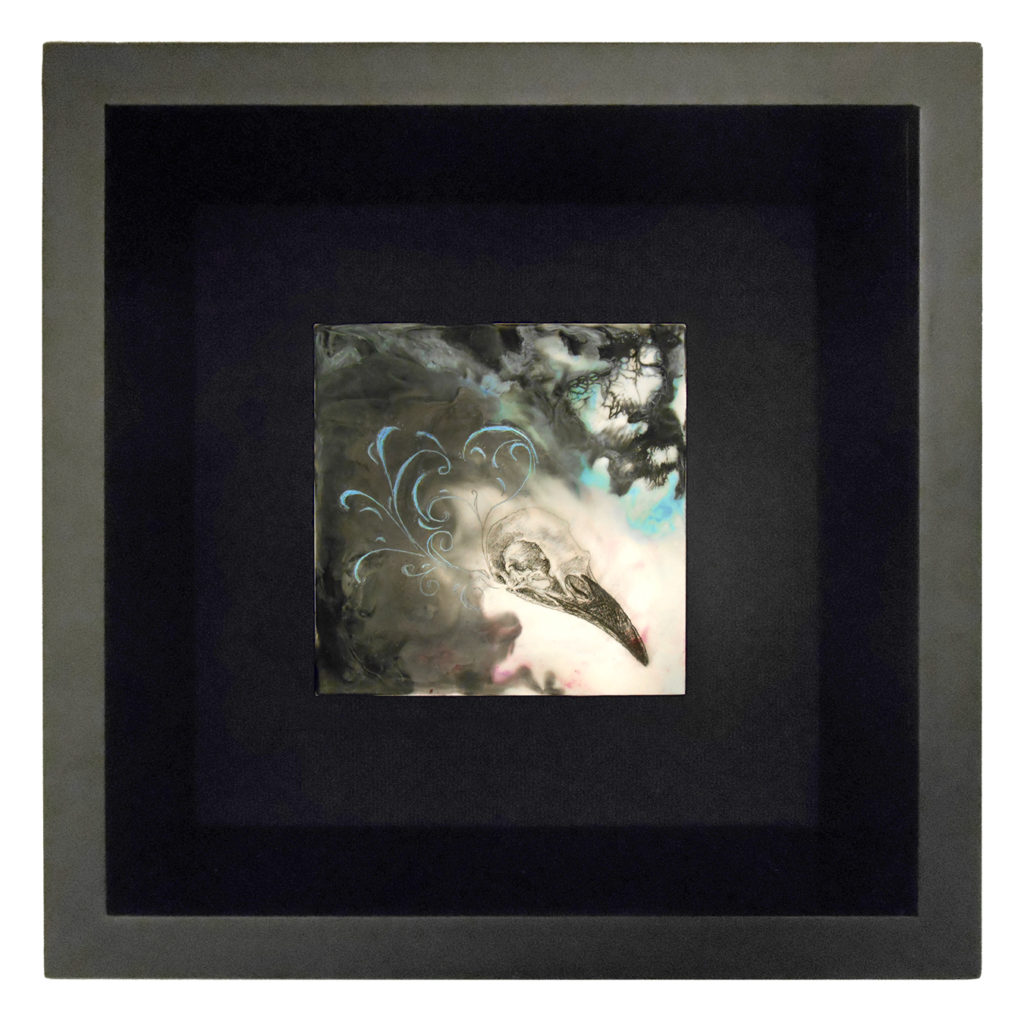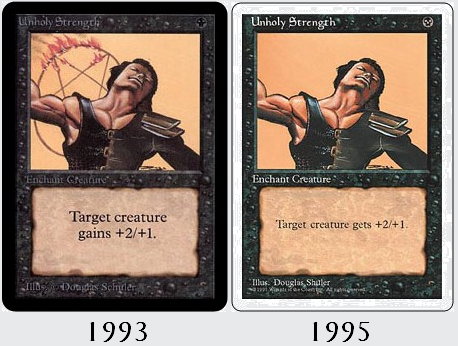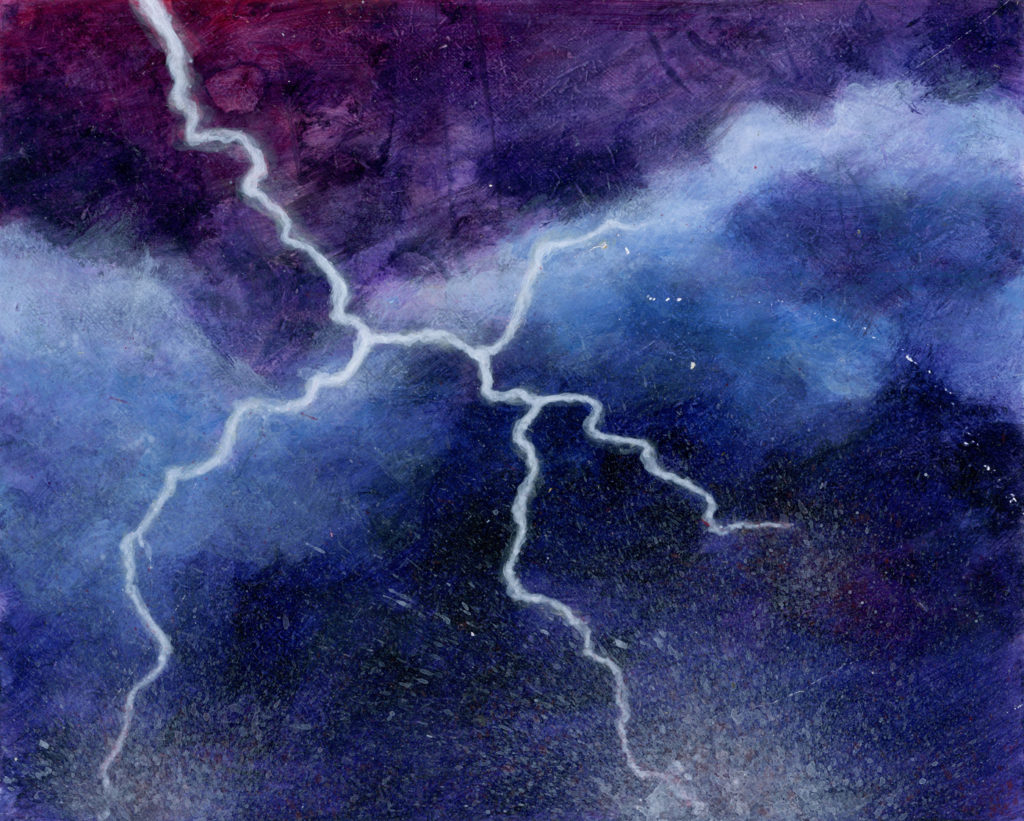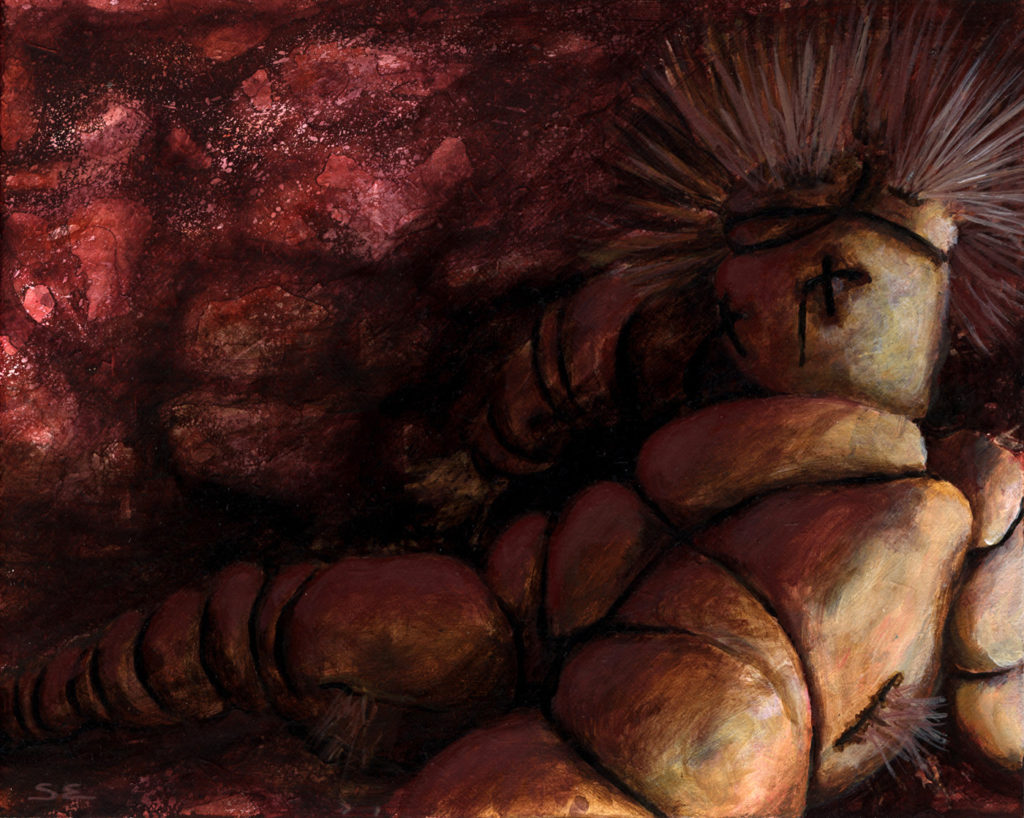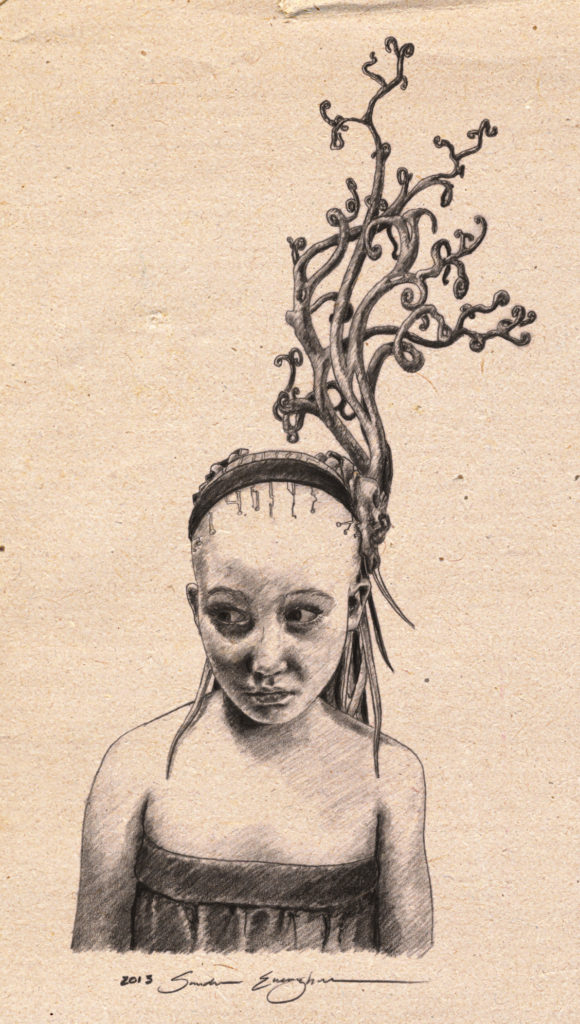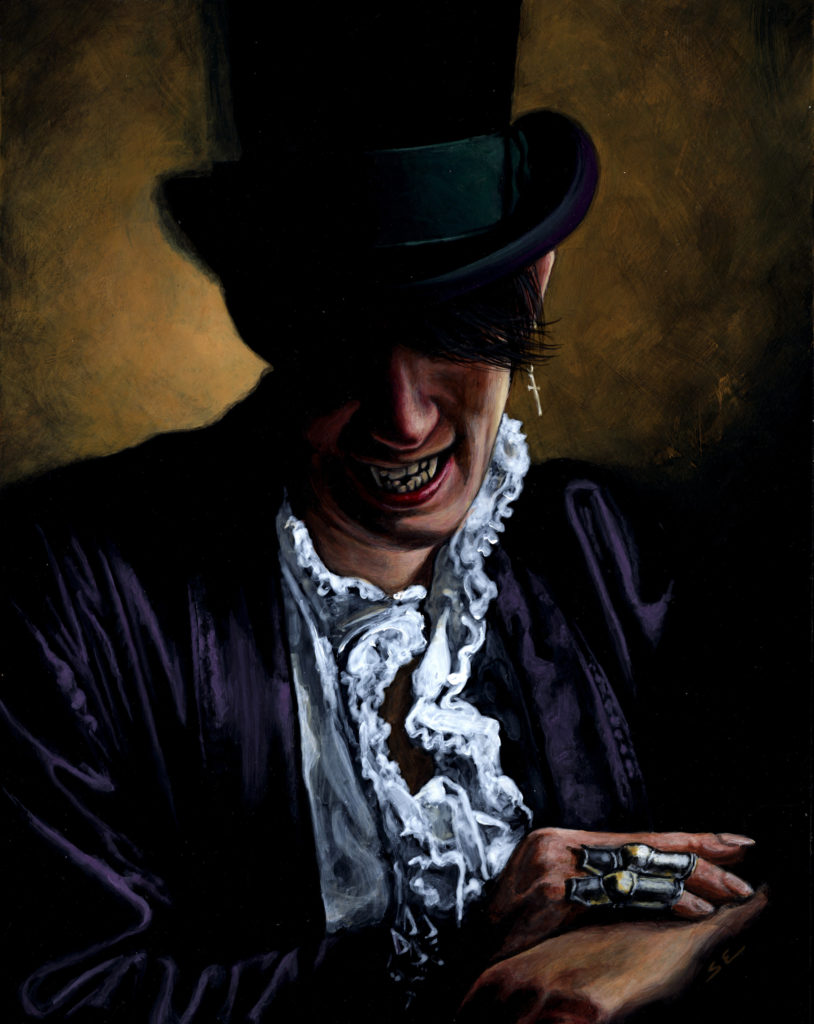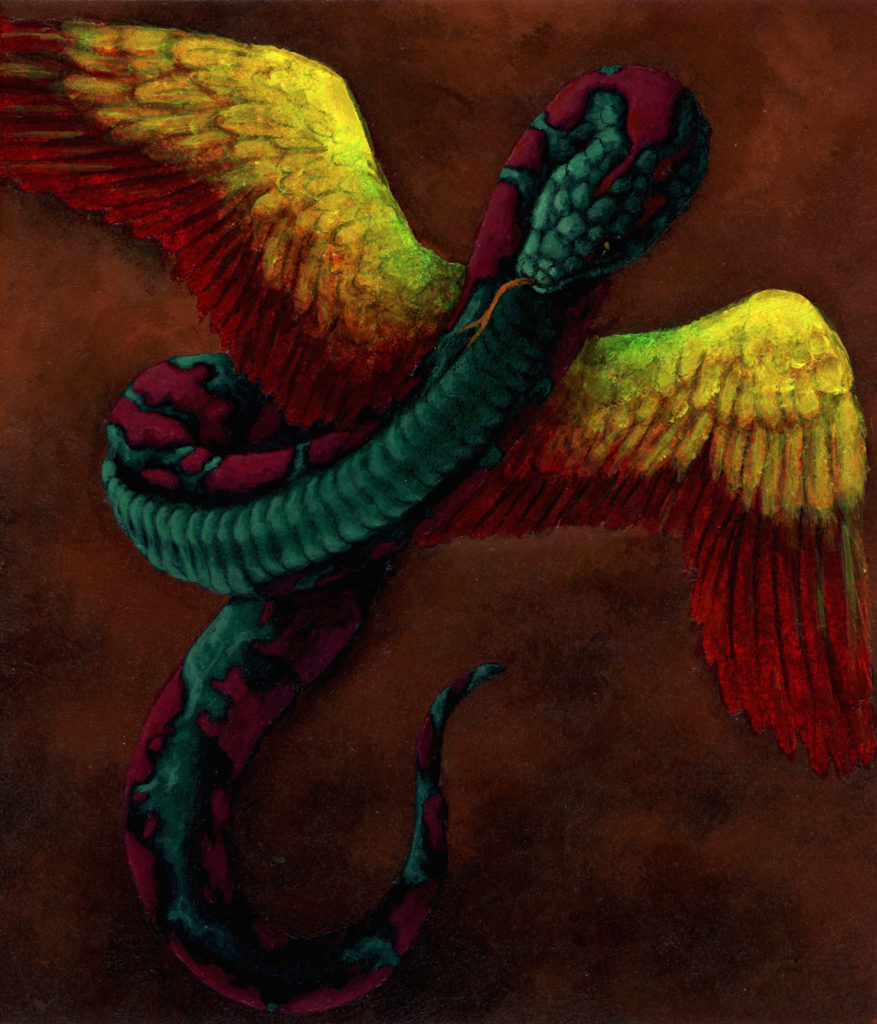Sandra Everingham is one of the original Magic artists. You know her work from [casthaven]Dark Ritual[/casthaven] to [casthaven]Chain Lightning[/casthaven]. Like many of the best original Magic artists, Sandra’s style is eclectic. There are realistic landscapes ([casthaven]Sinkhole[/casthaven], [casthaven]Raging River[/casthaven], [casthaven]Tidal Flat[/casthaven]), fantastic figures ([casthaven]Yawgmoth Demon[/casthaven], [casthaven]Puppet Master[/casthaven], [casthaven]Lady Orca[/casthaven]), magical objects ([casthaven]Book of Rass[/casthaven], [casthaven]Onyx Talisman[/casthaven]), to the bizarre and abstract ([casthaven]Hell’s Caretaker[/casthaven], [casthaven]Night Soil[/casthaven]), and the stuff of nighmares (I’m looking at you, [casthaven]Tourach’s Gate[/casthaven] and [casthaven]Evil Presence[/casthaven]). Let’s get to the interview!
Matt Jones: Sandra! Thanks for giving me the opportunity to interview you for Hipsters of the Coast! Dunno if you’ve seen my interview with Jesper Myrfors, there are a couple of stories he told me that involve you. You sound like an adventurous trouble maker! Before we get into your specific work for Magic and your beautiful drawings and paintings, are there any stories of the early days of Magic that you either haven’t told or haven’t told often? Our readers loved hearing Jesper’s stories and I have a hunch you’ve got some incredible tales.
Sandra Everingham: Yes, I read Jesper’s interview and he has always been an exceptional story-teller. I had forgotten about the picture Jesper snapped of me at Fort Warden … I am now curious about the other stories of me he told! Ha, adventurous trouble maker?! I’d consider myself adventurous with a large, healthy dose of cautiousness. You won’t hear about me jumping out of a plane or bungee jumping, but I do enjoy activities that involve staying on the earth.
I will need dust off the brain archives for a story or two from “the good old days of Wizards of the Coast.”
(Editor’s note: a day or so later…)
I thought of two stories/tid-bits that the long-time fans may have of heard about, but maybe not the newer Magic players.
When I was Art Director for Magic in the early days, part of my job was to press check the new releases at our printer in Turnhout, Belgium. I remember it being a quaint, beautiful town in the Flemish providence of Antwerp and I fell in love with it instantly. There was a main street of retail shops, a museum dedicated to the history of printing and some of the best restaurants I have ever experienced. The printing facilities were quite modern, with brightly colored walls and open floor plans. I remember having to wait long periods of time in their conference room in between press checks. How did I survive without a laptop and an iPhone in those situations? I also got to see the machinery that sorted the cards into their booster packs. Thousands and thousand of packs. 24 hour printing shifts at times. The volume was staggering. That was usually the point tour ended to attend another check or have lunch. After taking a trip to the print museum with our sales rep, he pointed up to an obviously old, ominous stone building and says, “Do you know what that is?” I shook my head. “That’s our prison. We send all the flattened Magic packaging and booster packs to the prison and the inmates do the product fulfillment.”
So yep, in the early days of Magic, boxes and booster packs saw the inside of a Belgian prison.
The second story is part Magic trivia and part “reluctantly drudging up the past.”
Q: Whose task was it to remove the burning pentagram in the background of Doug Shuler’s Unholy Strength in Photoshop?
A: Me. Yes, it was I who had to remove the symbol, unfortunately leaving Doug’s character with no context.
I remember that move made a lot of fans mad. That was a tough one for us at Wizards as we prided ourselves on artistic freedom and that the artists could choose how to best represent the card title given to them. I assume most people know by now the reasons and pressure the company was under with the unexpected mass market success, but it didn’t make it easy for us and we know it wasn’t easy for the fans to witness. Doug’s original art is a crucial part of Magic history and will continue to be.
MJ: I’ve had to go proof books being printed for my day job boss. Each time it’s a trip to Milan and me sitting in a conference room for ten hours, interrupted every couple of hours to look at the color of something coming out off the press. Then it was back to the room to read and doze. I ate the best food of my life and got to see a DaVinci ceiling and a Michelangelo Pieta (not THE Michelangelo Pieta) so I can’t complain too much.
I remember buying a pentagram pendant for a necklace because i thought the pentagram in Unholy Strength was scary and powerful and cool. I thought it was kinda funny as a kid that it was removed because of Christians complaining.
Is it ok to talk about how the switch from the old days of art to the new days of MTG art? I don’t know how many of our readers know about what happened when Wizards changed their policy towards Magic art. Jesper hinted at it a little and I’ve heard rumors but don’t really know what happened and why what happened prevents any of you original artists from painting anymore illustrations for Magic. I bet it wasn’t much fun when it was all going down and understand if you’d rather not talk about this (and I’ll not publish this question if you say “no thanks” to it). If you do have some things you feel comfortable talking about in regards to it we’d love to hear, but no pressure!!!
If that question is unanswerable here’s another:
Who approached you to make illustrations for Magic cards? What were you doing at the time? What was your art like then?
SE: I am going to answer the last question which is back story for the first question:
I was introduced to Wizards of the Coast by Jesper Myrfors in 1992. Jesper, Amy Weber and myself were Illustration majors at Cornish College of the Arts in Seattle. The three of us spent quite a bit of time together taking classes and going on the occasional photography excursion. In our senior year, Jesper had made contact with Wizards and was asked to work as their art director on this new game and asked me to be his production assistant. I grew up playing board and video games with my family so I was intrigued to learn more. We met at Peter Atkinson’s house where another individual brought out play test cards. This person proceeded to walk me through the mechanics of Magic: The Gathering and described the model of how the cards would be sold. I must have experienced goosebumps, because I had this visceral reaction and I was hooked into these dream-like possibilities. I felt the game was going to be huge, but I had no clue of the colossal tidal wave that was about to hit.
During the time I was helping scan, color correct and scale the art that would arrive at the office, Jesper encouraged me to illustrate some cards. By this point in college, I had moved toward fine art and was immersed in abstract painting. By the time Magic was released, I had my first show in a gallery downtown and intended to make that my career path. At the same time, I wholeheartedly believed in this game and I needed the work. So, down the Magic path I went …
Regarding your question about the transition of the art/artists, I can tell you what I remember up until 1996 when I left my position as AD for Magic. When it came to art commissioning, there were a couple of key turning points. The first, was the company wanted to start improving the technical quality of the art and at the same time honor the fan favorite artists and styles. I was asked to communicate this as best I could to the artists and to weed out some styles and find new talent. Not an easy task and that initiative continued well after I left. The second, was the transition from the cash + royalty payment system to the standard flat fee payment. It is not worth going into any details that about our initial internal contract discussions, but it was a sensitive and multi-faceted issue. Many of us were young and inexperienced in how to deal with an overwhelming amount of business success, so I feel we all tried to do the best we could with what we knew at the time.
I didn’t hear about artists dramatically being “banned” from Magic illustration, but I did know some of the original artists continued to create artwork while others were weeded out per the previously mentioned initiative. As far as I knew, it was at the discretion of the current AD and the working relationships that were developed. But, if you have heard rumors to the contrary, those are individual stories I am not familiar with. I also have to assume some left by choice. I removed MYSELF from illustrating for Magic and it had nothing to do with the company. I eventually decided that illustration was not the right career path for me. But in all honesty, even if I had wanted to keep illustrating, I knew I would have been weeded out by the next AD. Illustration was not where my talents shined, and I wanted to pursue other creative ambitions.
MJ: It’s been a real treat to hear about your involvement in the history of Magic illustration. You’ve been open and awesome about it all. Thank you! For the last question I’m hoping you’ll be able to share some examples of your current work and your thoughts on being a fine artist and not an illustrator‚—why you prefer to be one and not the other, what it means to you. It’d be great if you could tell us of any recent and upcoming events you’re involved in, where people can check out more of your work, etc.
SE: After Wizards of the Coast, my career path lead me to creating character and environment surfaces and UI design in the video game industry, managing the creative team for WizKids, running my own creative business, working in advertising, to now being the creative director for a merchandise agency. Interwoven in that, I enthusiastically jumped at opportunities to sketch concepts for clients, or create something that had personal meaning. My business card may have a title on it, but I no longer call myself, or don’t call myself, a fine artist, an illustrator or a designer. I create … in what ever form that may take.
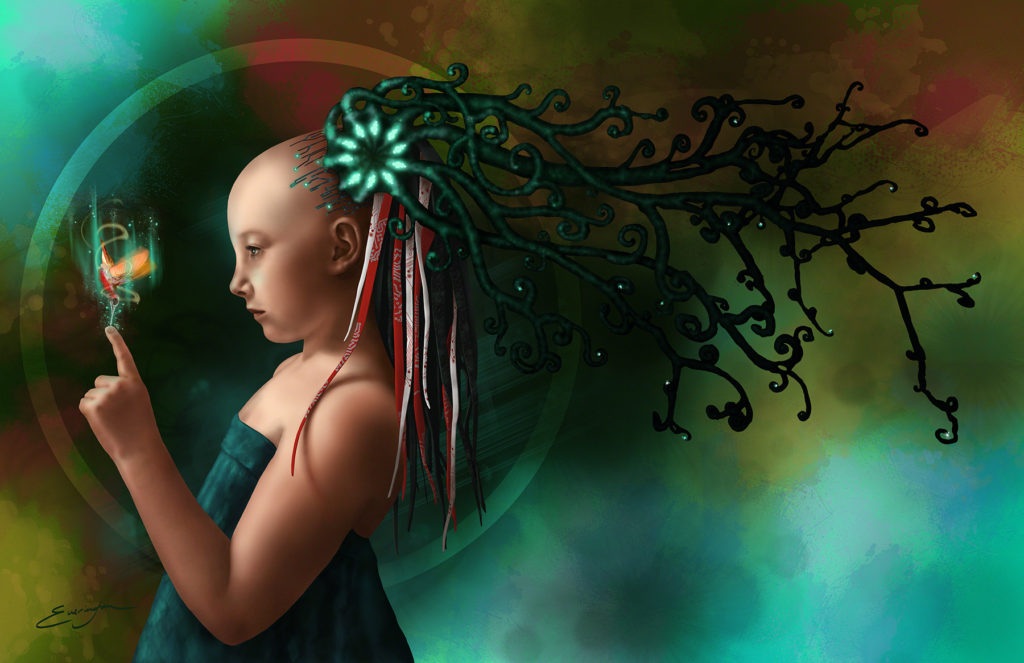
Symbiosis—Digital over scanned graphic drawing (featured in The Gathering 20th anniversary book) Won Honorable Mention in the 2014 Digital Art Festival Awards
Personally, the two differences between being a fine artist and an illustrator was, where the direction came from and the emotional connection it would generate. Besides painting and graphite, I’ve created mix media stained glass, jewelry assemblage, digital, and the most recent experiment, encaustic wax. My process of creating personal work has been a journey of desperately needing to express an internal feeling, a vision or trying something new and then not failing at it. FAILURE. That word makes me rolls my eyes and laugh at myself now. As I have gotten older, I have seen how ridiculous the concept of failure is when it pertains to creation. It doesn’t exist. Creation is a process and a series of stepping stones that light up in front of you at the very moment you decide to move forward.
I rarely have time to produce new work but the last show one was last year at Krab Jab Studio, run by the amazing power house, Julie Baroh. I am currently working on a limited run of graphite drawings in the borders of the Symbiosis prints for Vintage Magic. I am loving graphite at the moment because it’s bringing me back to rendering basics.
The illustration for Chain Lightning, I could look at it every day forever and not get bored. It’d be amazing to own that thing. It’d be so sweet walking past it on the way to the shower in the morning, pausing, barely conscious, staring into the overwhelming power of nature and the beauty of trying to depict that power. All for a card game we love. Ridiculous how good life is, eh? And, seriously, Dark Ritual. THE Dark Ritual. I felt like a bad ass sorcerer casting that spell into Necropotence turn one. Maybe I was the only kid in my local play group that understood what a douchey powerful move that was, and maybe I refused to play with my Necro deck without wearing a crimson cape whilst holding an illegibly scribbled upon book. MAYBE I BELIEVE IN GREEN FIRE!!!
Many thanks to Sandra for sharing these stories and all of her art work. I think we’ve all forgiven her for removing the pentagram in Unholy Strength. (Hail Satan!)
Matt Jones (born on at the beginning of the 8th decade of the 2oth century) is an artist living and working in Brooklyn, NY. Matt’s played Magic since Revised. Lately Matt’s game has become more about hanging out with friends and shooting the shit and less about competitive tournament play. He writes the weekly Arting Around column on Hipsters of the Coast, interviewing Magic illustrators and occasionally adding his thoughts on the art of various cards and sets. You can see Matt’s artwork on his website.

